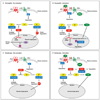Regulation of Hedgehog signaling by ubiquitination
- PMID: 26366162
- PMCID: PMC4564008
- DOI: 10.1007/s11515-015-1343-5
Regulation of Hedgehog signaling by ubiquitination
Abstract
The Hedgehog (Hh) signaling pathway plays crucial roles both in embryonic development and in adult stem cell function. The timing, duration and location of Hh signaling activity need to be tightly controlled. Abnormalities of Hh signal transduction lead to birth defects or malignant tumors. Recent data point to ubiquitination-related posttranslational modifications of several key Hh pathway components as an important mechanism of regulation of the Hh pathway. Here we review how ubiquitination regulates the localization, stability and activity of the key Hh signaling components.
Keywords: Hedgehog signaling; ubiquitination.
Figures

Similar articles
-
Protein modifications in Hedgehog signaling: Cross talk and feedback regulation confer divergent Hedgehog signaling activity.Bioessays. 2021 Dec;43(12):e2100153. doi: 10.1002/bies.202100153. Epub 2021 Nov 5. Bioessays. 2021. PMID: 34738654 Review.
-
Regulation of Hedgehog Signal Transduction by Ubiquitination and Deubiquitination.Int J Mol Sci. 2021 Dec 11;22(24):13338. doi: 10.3390/ijms222413338. Int J Mol Sci. 2021. PMID: 34948134 Free PMC article. Review.
-
Deubiquitination of Ci/Gli by Usp7/HAUSP Regulates Hedgehog Signaling.Dev Cell. 2015 Jul 6;34(1):58-72. doi: 10.1016/j.devcel.2015.05.016. Epub 2015 Jun 25. Dev Cell. 2015. PMID: 26120032 Free PMC article.
-
E3 ligase Herc4 regulates Hedgehog signalling through promoting Smoothened degradation.J Mol Cell Biol. 2019 Sep 19;11(9):791-803. doi: 10.1093/jmcb/mjz024. J Mol Cell Biol. 2019. PMID: 30925584 Free PMC article.
-
Neuropilin-1 promotes Hedgehog signaling through a novel cytoplasmic motif.J Biol Chem. 2017 Sep 15;292(37):15192-15204. doi: 10.1074/jbc.M117.783845. Epub 2017 Jun 30. J Biol Chem. 2017. PMID: 28667171 Free PMC article.
Cited by
-
Non-apoptotic caspase activation ensures the homeostasis of ovarian somatic stem cells.EMBO Rep. 2023 Jun 5;24(6):e51716. doi: 10.15252/embr.202051716. Epub 2023 Apr 11. EMBO Rep. 2023. PMID: 37039000 Free PMC article.
-
Set7 mediated Gli3 methylation plays a positive role in the activation of Sonic Hedgehog pathway in mammals.Elife. 2016 May 5;5:e15690. doi: 10.7554/eLife.15690. Elife. 2016. PMID: 27146893 Free PMC article.
-
Differential Expression of Genes for Ubiquitin Ligases in Medulloblastoma Subtypes.Cerebellum. 2019 Jun;18(3):469-488. doi: 10.1007/s12311-019-1009-y. Cerebellum. 2019. PMID: 30810905
-
Hedgehog Pathway Activation Alters Ciliary Signaling in Primary Hypothalamic Cultures.Front Cell Neurosci. 2019 Jun 12;13:266. doi: 10.3389/fncel.2019.00266. eCollection 2019. Front Cell Neurosci. 2019. PMID: 31249512 Free PMC article.
-
Primary Cilia as Signaling Hubs in Health and Disease.Adv Sci (Weinh). 2018 Nov 16;6(1):1801138. doi: 10.1002/advs.201801138. eCollection 2019 Jan 9. Adv Sci (Weinh). 2018. PMID: 30643718 Free PMC article. Review.
References
-
- Apionishev S, Katanayeva NM, Marks SA, Kalderon D, Tomlinson A. Drosophila Smoothened phosphorylation sites essential for Hedgehog signal transduction. Nature cell biology. 2005;7:86–92. - PubMed
-
- Aza-Blanc P, Lin HY, Ruiz i Altaba A, Kornberg TB. Expression of the vertebrate Gli proteins in Drosophila reveals a distribution of activator and repressor activities. Development. 2000;127:4293–4301. - PubMed
-
- Aza-Blanc P, Ramirez-Weber FA, Laget M-P, Schwartz C, Kornberg TB. Proteolysis that is inhibited by hedgehog targets Cubitus interruptus protein to the nucleus and converts it to a repressor. Cell. 1997;89:1043–1053. - PubMed
Grants and funding
LinkOut - more resources
Full Text Sources
Other Literature Sources
